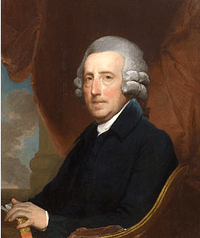Thomas Dawes

Thomas Dawes (August 5, 1731 – January 2, 1809) was a Patriot who served as a Massachusetts militia colonel during the American Revolution and afterward assumed prominent positions in Massachusetts's government. His positions included membership and chairmanship of the Massachusetts Governor's Council and representative in both the House and Senate. As chairman of the Governor's Council, Dawes served briefly as the de jure presiding officer of the executive branch of Massachusetts' state government for ten days – May 20, 1800 to May 30, 1800 – following the death of first Governor Increase Sumner and then Lieutenant Governor Moses Gill. (See List of Governors of Massachusetts.)
Dawes was born in Boston. Prior to the Revolution, he attended a regular school and worked as a mechanic. He ardently supported the Whigs, gaining infamy among Royalists; his house was plundered by the British when they withdrew from Boston in 1776. Later, he became active in politics, lived in a roomy house on Purchase Street beside John Adams, and worked as an architect and builder designing many notable buildings in Boston, including the Old Street House and the Brattle Street Church. He was elected a Fellow of the American Academy of Arts and Sciences in 1784.[1] He attended Old South Church from 1786 until his death in 1809, and was a good friend of John Hancock.
Dawes, a member of the prominent Dawes family of Massachusetts Bay, was a cousin of the April 1775 Whig patriot William Dawes. He married Hannah Blake on July 1, 1752. Their son Thomas Dawes (July 8, 1757 – July 21, 1825) was a jurist and an alumnus of Harvard University, graduating in 1777, and served in the Massachusetts Supreme Judicial Court from 1792 to 1802; he married Margaret Greenleaf.
References
- ↑ "Book of Members, 1780–2010: Chapter D" (PDF). American Academy of Arts and Sciences. Retrieved July 28, 2014.
Further reading
- Frederic C. Detwiller. Thomas Dawes: Boston's patriot architect. Old-Time New England, 1977.
| Legal offices | ||
|---|---|---|
| Preceded by Francis Dana |
Associate Justice of the Massachusetts Supreme Judicial Court 1792–1802 |
Succeeded by Theodore Sedgwick |